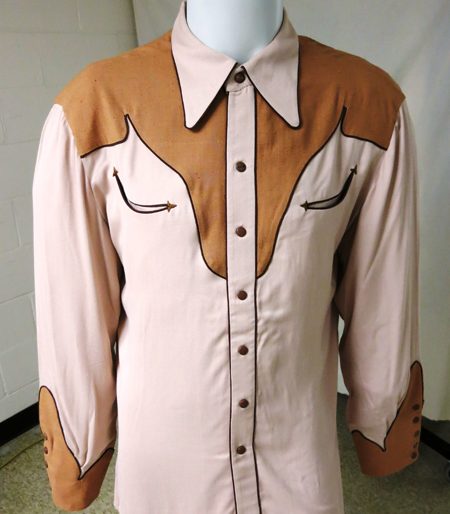Costume collections manager Jessica Pushor writes about a fine example of western wear from the Museum’s costume collection.
Western wear and high-quality custom tailoring may not seem like they go hand in hand, but there was a time when western wear provided some of the finest examples of Old World tailoring techniques. While searching for a 1970s men’s dress shirt to pair with the Pucci suit in Chicago Styled: Fashioning The Magnificent Mile® (November 15, 2014–August 16, 2015), we unearthed this Nathan Turk shirt.

Men’s western wear shirt worn by Philip K. Wrigley, c. 1960. Gift of William Wrigley III, 1979.180.23. All photographs by CHM staff
The 1930s through the 1970s is considered the golden era of western wear. It began with singing cowboys, such as Gene Autry and Roy Rogers, who were featured on radio, television, and in movies, and needed costumes to create a larger-than-life cowboy look for their public appearances. Nathan Turk (real surname Teig) was a Jewish immigrant from Eastern Europe who, along with Nudie Cohn, helped establish the blueprint for the ornate western wear that adorned film, music, and rodeo stars in the 1930s. He built a niche within the early western wear business, combining Old World embroidery and tailoring traditions with cowboy style to create a totally new type of garment.
Turk began making a name for himself in the 1930s by creating equestrian and western outfits for riders in the Rose Bowl Parades held in Pasadena, California. When Gene Autry left the National Barn Dance radio program on WLS-AM in Chicago in the mid-1930s and moved to Los Angeles to begin his film career, he asked Turk to create his movie wardrobe. Autry was already accustomed to such clothing having purchased western wear from Bernard “Rodeo Ben” Lichtenstein, who worked out of Philadelphia and sold his clothes at large rodeos on the East Coast, such as the Madison Square Garden Rodeo in New York City.
Turk, working out of a small shop in Los Angeles, made tailored suits from expensive gabardines and used traditional techniques, such as hand-stitched arrowheads, to reinforce seams and pockets, piped collars, yokes, and cuffs. His designs were a performer’s spin on traditional cowboy clothes and an extension of flashy rodeo style. It was the perfect look for movie cowboys, who made many public appearances, and this soon lead to many musicians asking for the same sort of flamboyant stage clothes.
These brightly-colored western wear costumes featured fringe, embroidery, and rhinestones. Gene Autry and Roy Rogers were not actual cowboys, they were Hollywood’s depiction of cowboys, and to play the part, they wore outfits designed to take away their viewers’ breath. These clothes became much more important than just costumes to the stars and their fans. The tailors creating the custom garments made western wear a new trend. Tourists visiting dude ranches in the 1950s and 1960s helped spread this fashion further when they brought western wear back to their homes.
One example of fine western wear tailoring is this men’s peach-colored, snap front shirt that was owned by Philip K. Wrigley (December 5, 1894–April 12,1977), owner of the Wrigley Company and the Chicago Cubs baseball team. His son, William Wrigley III, donated it to the Chicago History Museum’s costume collection in 1979. The cotton blend shirt has light brown yokes and cuffs, brown piping throughout, two smile pockets with arrowhead points, brown enamel snap buttons, and wide pointed lapels. It also features high-quality details such as finished seams, quilted collar stand, satin lined pockets and yokes, and hand-finished details.

The cheerful smile pockets feature arrowhead points in the corners.

Each cuff features five snap buttons.

Turk’s label also effectively served as an advertisement for his business.
The shirt includes the label of Turk’s Ventura Boulevard shop in Los Angeles where he sold both custom pieces and off-the-rack items. All were finely tailored and quite expensive. This artifact speaks to the popularity for all things western and cowboy-related that gripped America for more than forty years.